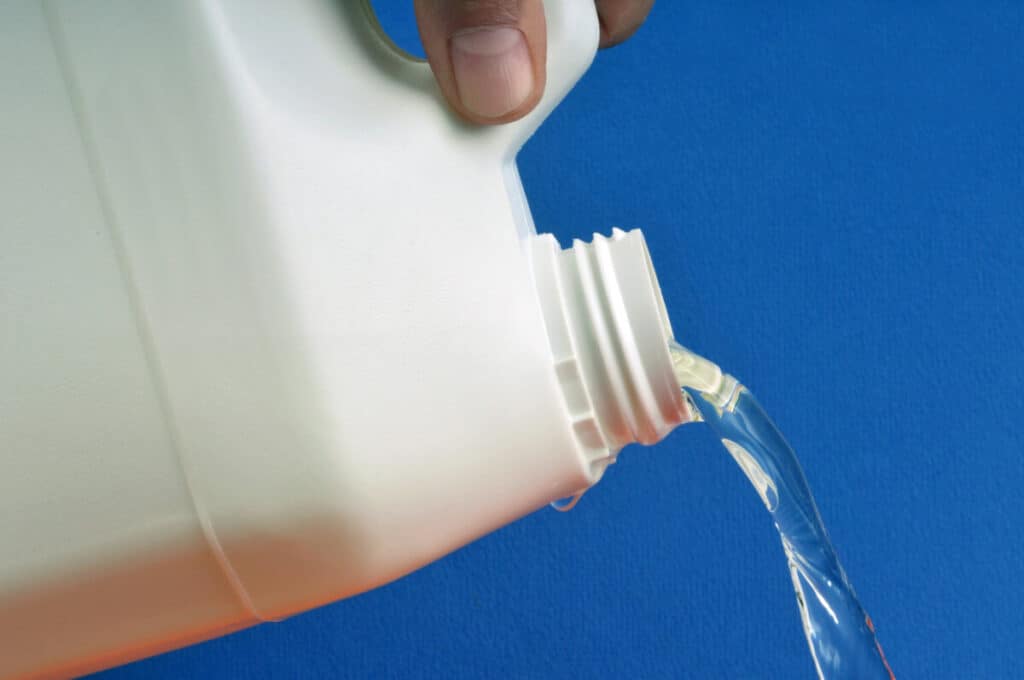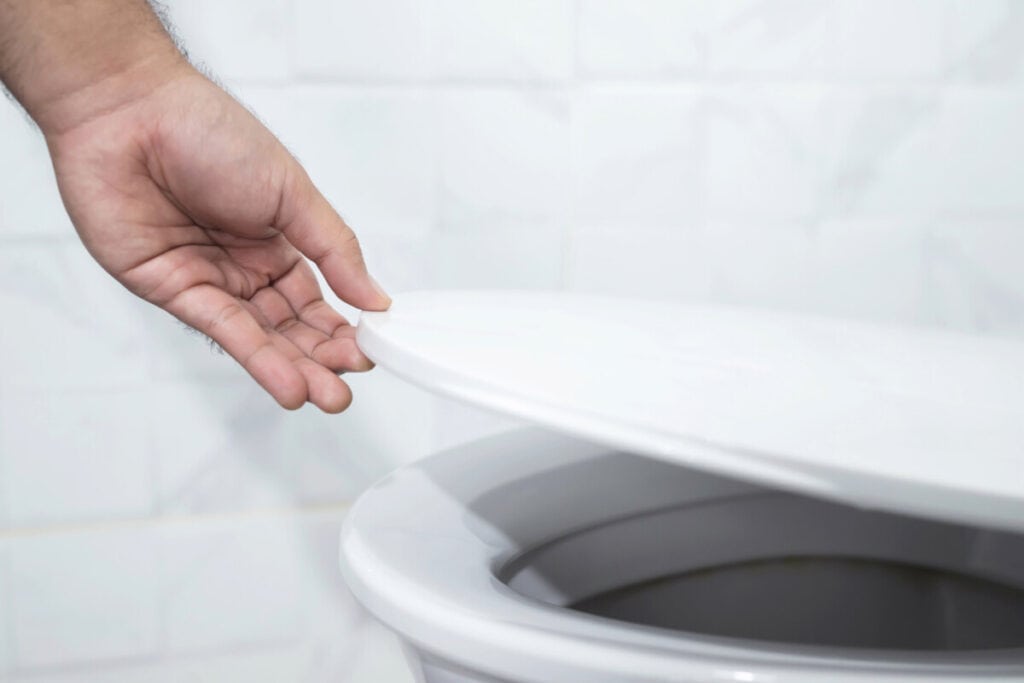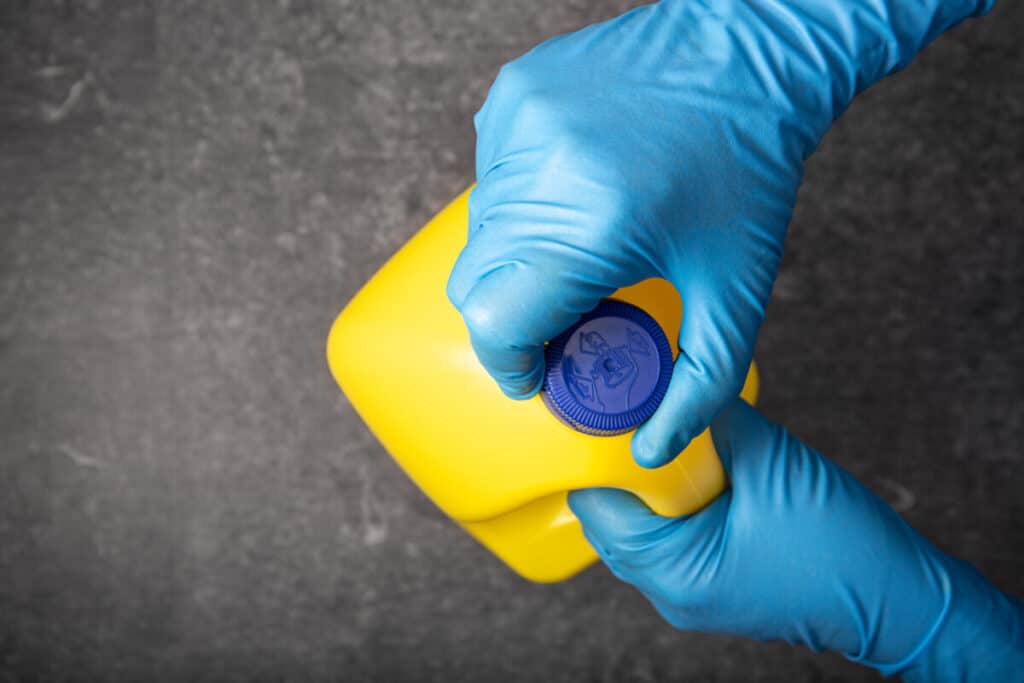
Do you often clean your home with bleach? Are you wondering if you are disposing of the bleach correctly? If you are asking yourself any of these questions, this article can help you become educated on how to dispose of bleach.
Bleach can be disposed of by pouring it down the kitchen drain, the toilet, a septic tank, or the bathtub drain. It should not be poured straight down the drain but should be properly diluted to be disposed of. The container the bleach was stored in should also be prepared for disposal.
If you would like to continue learning about how to dispose of bleach and the effects it can have on the environment, keep reading!
Pouring Bleach Down the Kitchen Drain
While it is not ideal, you can dispose of bleach by pouring it down the kitchen drain. To start, it is important that you turn on the faucet and have the water running to prepare the sink and drain. You will want the sink and drain to have the flow of water going in order to help dilute the bleach as it goes down and enters the drain to make sure the harsh chemicals don’t deteriorate or eat away at the sink or drain and cause any major damage.
When the bleach is diluted as it runs through the water into the drain, it will continue to be diluted as it enters the industrial wastewater after it exits the drain before the remaining chemicals go into a wastewater treatment plant. That is where the diluted bleach will end up and the treatment plant will take care of it from there, making sure it doesn’t enter any of the access points where we get water such as the water from our sinks, bath tubs, toilets, etc.
If you are concerned about any remaining bleach in your sink transferring to dishes and food, it is also important to note that after disposing of the bleach, although it was diluted from the running water, you should scrub the sink and drain it with hot water and soap to get rid of any remains of bleach that could make you sick. This is just as important as getting rid of the bleach safely. You don’t want to accidentally ingest or inhale large amounts of bleach because that can make you extremely sick and is just as dangerous as not disposing of the used bleach.
Pouring Bleach Down the Toilet

Disposing of bleach down the toilet is a very similar process to disposing of it down the kitchen sink except there is no faucet above the toilet to flush water down, so in this case, you would flush the toilet a few times in place of that step. As you then pour and flush the diluted bleach down the toilet, the natural biodegradation within the sewage systems, as well as the municipal treatments, can neutralize most of the harmful chemicals from the bleach in addition to it already being diluted.
The process of pouring bleach down the toilet is a safe way to dispose of bleach because the flushing of water as the bleach goes down the toilet dilutes it, allowing the bleach to move into the sewage system safely. It is important to note that if you have larger amounts of bleach to dispose of (anything over a quarter of a gallon) you should dilute the bleach in sections and flush them each separately, so as not to overfill and overwhelm the toilet bowl, as well as to make sure the bleach that you are flushing gets diluted sufficiently. If you can’t do that, make sure to add more water to the bowl before flushing.
Just as we discussed with the sink, it is still important, if not more important to clean both the inside and outside of the toilet after disposing of the bleach. Even though you won’t be putting dishes or food in the toilet, you will have people, family members, and even little kids being around and touching the toilet and you will want to make sure that it is not dangerous to have them touch or inhale too much bleach by being around and using.
Pouring Bleach Down a Septic Tank
Clinical studies have shown that even bleach that hasn’t been diluted prior to being poured down a septic tank has little to no effect on any of the microorganisms that were in the water. The bacteria that is found in septic tanks can recover quickly from contaminants, such as disposed of bleach. Studies have also shown that 1.3 gallons of undiluted sodium hypocrite bleach in a standard 1,000-gallon septic tank would not do any harm to the microorganisms or to the septic’s tank bacterial activity.
To give you a reference, 1.3 gallons of bleach is not typical for the average household to use in regards to cleaning within a year time period, so if you are concerned about putting too much bleach in your septic tank and having poor consequences follow, don’t worry too much because even a large amount that you could dispose of normally won’t do too much harm to the septic tank.
This may be confusing because we have talked about in regards to disposing of bleach in the sink and toilet and the importance of diluting it before dumping it down the toilet or sink. The reason that disposing of the bleach in the septic tank without diluting it, is because the water in the septic tank has bacteria that will counter the harmful chemicals in the bleach, making it less dangerous.
Pouring Bleach Down a Bathtub Drain
Using the bathtub drain to dispose of bleach is very similar to doing it with the toilet and the sink. One caveat is that before you pour anything down the tub drain, it is important to clean your tub beforehand, without bleach. You will want to have a clean tub to work with that is free of any residue from any soap, body wash, shampoo, etc. This is to help prevent the bleach from attaching to any of those previously remaining chemicals that could create strong odors of bleach or have those harsh chemicals remaining in the tub.
Now the process is exactly the same as before. You will want to run the tap for a minute to allow the water to run over the base of the tub and to prepare the drain for the bleach. Again, this is to allow for the bleach to be diluted before entering the drain to prevent any damage to the drain or also in this case, the base of your tub. Once the diluted bleach has gone down the drain, it will follow the same process as it does when going down the sink.
The aftercare of the bathtub is also just the same as the toilet and sink. You will want to again clean your tub and drain with a non-bleach cleaner to get rid of any residue of bleach that has been leftover. It is key both before and after to use a cleaner that is non-bleach based because you are trying to get rid of the chemicals that were in the bleach, to begin with and you don’t want to continue to add to those and have that be counterproductive.
How To Dispose of a Bleach Container

Now that you have disposed of the bleach that you have used, it is inevitable that you will at some point end up with an empty bleach container. Just like you should dispose of the bleach in a specific, careful way, you should do the same with the empty container.
The first thing you will want to do is to look at the container and see if it is recyclable or not, some are and some are not. In addition to noting if it is recyclable or not, some labels will also tell you if there are special instructions to follow. If that is the case you can follow those, this will just be a general guideline of what to do with the container. Some companies even have mail-back options, meaning that when you are done with the container you can mail it back to the provider and they will properly dispose of it.
For example, if you look on the label and you see the letters “PET” or “HDPE”, those are key indicators that the container is recyclable. If you choose to recycle it personally or decide to mail it back for the company to dispose of, it is important to make sure that the container is in fact empty, you cannot recycle or mail back a bottle that has any remains of bleach it in.
Why You Should Avoid Disposing of Bleach Outside
Disposing of bleach outside doesn’t have much of a different protocol than it does when disposing of it down sinks or tubs. It still requires that you dilute it well and dispose of it in small amounts.
The highly diluted bleach in small amounts may even have benefits for your plants with the chlorine content. Be wary though, because bleach that hasn’t been diluted enough can kill your plants. One of the ingredients in bleach, sodium hydrochloride, is highly reactive and is broken down by sunlight into compounds found in the air. When it is mixed with soil and water, sodium hypochlorite does not appear and breaks down into sodium, hypochlorite ions, and hypochlorous acid molecules. The purpose of sodium hypochlorite is to increase the salt content of the soil and depletes the quality of minerals the plant needs.
A study showed that a plant that had received too much sodium hypochlorite reduced the amount of water in the plant’s roots and increased the toxicity of chloride. When there is too much chloride moving through the plant it limits its ability to grow and transport water between cells as well as inhibits its ability to photosynthesize, essentially stunting the growth of the plant and killing it. In short, be very careful of the amount of bleach that is being put on your plants because too much can be more harmful than helpful.
How Bleach Affects the Environment
Now that we have discussed all these ways to safely dispose of bleach, why is it so important to do so? How would the environment be affected if we didn’t take proper care of the bleach we had been using?
Water Pollution
The major element of concern that bleach brings is that it is full of chlorine. While chlorine may be familiar to you in regards to your swimming pool, it is used in small amounts that don’t have much of an effect. Because chlorine is essentially a poisonous gas, when it mixes with other elements, like various minerals in the water, it can produce dangerous toxins in the water. Coming in contact with these toxins has been said to cause illnesses such as breast cancer.
Air Pollution
While the factories that produce bleach do release toxins into the air, there have been processes put in place that can control the amount of bleach that is released and can be recycled. In cases where there aren’t those preventative processes put in place, the excess bleach released into the air can cause health issues with your immune system and heart.
Poor Effects On Wildlife
By-products of bleach have been known to have harmful effects on wildlife, such as the bald eagle and other bird and fish species. It has been discovered that the by-product, dioxins are the main culprit for this. The WWF has made statements warning that when certain species of wildlife are exposed to chlorine bleach it can cause mutations, and sterility, and even can ultimately lead to extinction.
Dangers of Sodium Hydrochloride Bleach
Being around large amounts of sodium hydrochloride bleach can make us experience symptoms like coughing from fumes, lung and throat irritation, blistering on the skin, and stomach and abdominal pain. If the fumes are strong enough or if you are exposed for a long period of time, delirium is also a possible symptom. If you find yourself in this situation here are a few things you can do to slow the effects until medical assistance is reached:
Call poison control and avoid ingesting liquids or vomiting. If the bleach has entered your eyes or made contact with your skin, flush with water, and if you have inhaled a large number of fumes, quickly move to fresh air.
Related Topics:
If you like the article above, here are some other similar articles you should check out!
How to Dispose of Old Medicine
